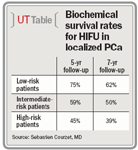Article
High-intensity focused ultrasound results similar to external beam radiotherapy in large prostate cancer series
High-intensity focused ultrasound as primary therapy for localized prostate cancer can produce outcomes that equal external beam radiation therapy.

The overall outcomes from a series of 880 consecutive patients show steadily improving results as HIFU technology continues to improve, said first author Sebastien Crouzet, MD, of Edouard Herriot Hospital, University of Lyon, Lyon, France.
"We are on the third generation of HIFU, and the outcomes get better with each advance," Dr. Crouzet said. "We have followed some patients as long as 10 years and are reaching results very similar to EBRT. The main issue is that you can repeat HIFU if you see evidence of disease."
Patients with recurrent prostate cancer were offered a second HIFU treatment. If patients showed evidence of recurrence following a second round of HIFU, they were offered salvage EBRT or hormonal therapy.
"Unlike many treatments, HIFU does not represent a therapeutic impasse," Dr. Crouzet explained. "If disease continues to progress, you can add salvage therapy to achieve very good control of the disease."
A total of 880 patients were included in the study. The mean age was 70 years and the mean PSA at first HIFU treatment was 8.4 ng/mL. Within the cohort, 36% had low-risk disease, 48% had intermediate-risk disease, and 16% had high-risk disease. Gleason scores were 6 in 58% of men, 7 in 34%, and 8 or higher in 8%. Patients received a mean of 1.4 HIFU treatments. The mean PSA nadir was 0.45, and 69% of patients reached 0.3 or lower. The mean follow-up period was 41 months.
The overall 7-year survival rate was 90%, and the 7-year cancer-specific survival rate was 98%, Dr. Crouzet reported. Seven years after HIFU, 96% of patients were free of visible metastases.
The 5-year biochemical survival rates were 75%, 59%, and 45% for low-, intermediate-, and high-risk patients, respectively. Seven-year biochemical survival rates were 62%, 50%, and 39% for low-, intermediate-, and high-risk patients, respectively (p=.0001). A total of 239 patients had biopsy-proven local relapse after a second HIFU treatment. Of this group, 156 patients had salvage EBRT and 83 patients received androgen deprivation.
HIFU represents a viable treatment option for men who want to minimize the risks of incontinence and erectile dysfunction that accompany radical prostatectomy, Dr. Crouzet said.
"Disease control and survival rates with HIFU are very encouraging, and you have the advantage that HIFU is very minimally invasive. When applying HIFU for focal therapy, you don't touch the nerve and you don't touch the sphincter, so you avoid the side effects of more invasive treatment," he said.
Newsletter
Stay current with the latest urology news and practice-changing insights — sign up now for the essential updates every urologist needs.
















